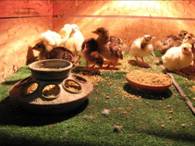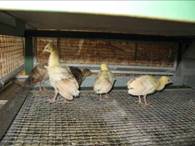Back to Peafowl Articles
Getting the Right Start
Craig Hopkins
One of the most common questions that I answer in the spring is how to brood peachicks and how to get them to eat and drink once they have hatched out. This question normally comes from people who have hatched their peafowl eggs in an incubator or removed the eggs from a broody hen or goose and allowed them to hatch out in a hatcher. If a peahen hatches out her own eggs or a broody hen is allowed to raise the chicks, the mother will brood the chicks and teach them how to eat and drink.
 The chicks are left in the hatcher for a day after they hatch.
This gives them plenty of time to completely dry off and to gain enough
strength to stand. The chicks are
then placed in a small, wooden brooder using a heat lamp for warmth.
I use a red colored, 250 W, heat lamp bulb so that the light levels in
the brooder are kept low so that the chicks wonít pick on each other.
Chicks under a week old should be kept in small groups so that they learn
to eat and drink without having to compete with one another.
Chicks sometimes have to be taught to eat and drink. This can be done by
placing a teacher chick, which is 3 to 4 days older and has learned to eat and
drink, in with the new chicks. Baby
chickens or pheasants can also be used as teacher chicks.
If no teacher chick is available, I place a shiny marble in the shallow
feed dish and the 1 quart water container for the chicks to pick at.
While picking at the marble, they will learn to eat and drink at the same
time. I have also used finely
chopped lettuce or grass clippings along with their starter feed to encourage
the chicks to eat. The green color
of these seems to attract the chicksí attention and provides a natural food
source for the chicks. Make sure to
use a shallow water container so that chicks donít drown.
We use a 20% medicated, chicken starter crumble for the first 4 months of
a chickís life. At 4 months of
age, the chicks are switched to a medicated chicken grower pellet of 18%
protein.
The chicks are left in the hatcher for a day after they hatch.
This gives them plenty of time to completely dry off and to gain enough
strength to stand. The chicks are
then placed in a small, wooden brooder using a heat lamp for warmth.
I use a red colored, 250 W, heat lamp bulb so that the light levels in
the brooder are kept low so that the chicks wonít pick on each other.
Chicks under a week old should be kept in small groups so that they learn
to eat and drink without having to compete with one another.
Chicks sometimes have to be taught to eat and drink. This can be done by
placing a teacher chick, which is 3 to 4 days older and has learned to eat and
drink, in with the new chicks. Baby
chickens or pheasants can also be used as teacher chicks.
If no teacher chick is available, I place a shiny marble in the shallow
feed dish and the 1 quart water container for the chicks to pick at.
While picking at the marble, they will learn to eat and drink at the same
time. I have also used finely
chopped lettuce or grass clippings along with their starter feed to encourage
the chicks to eat. The green color
of these seems to attract the chicksí attention and provides a natural food
source for the chicks. Make sure to
use a shallow water container so that chicks donít drown.
We use a 20% medicated, chicken starter crumble for the first 4 months of
a chickís life. At 4 months of
age, the chicks are switched to a medicated chicken grower pellet of 18%
protein.
 The rule of thumb in brooding peafowl chicks is to start the chicks out
with a brooder temperature of 95 degrees F and decrease this temperature by 5
degrees for every week of age. Brooders
can be made at home or can be bought commercially.
The brooder should provide a consistent heat source so that the chicks
donít become chilled or overheated. The
heating area should be large enough so that the chicks donít have to pile on
top of one another to stay warm. The
brooder should have a wire bottom floor so that droppings and wasted feed fall
through. For the very young chicks,
I cover the wire with an indoor/outdoor mat so that starter feed crumbles can be
scattered about for the chicks to pick at. Brooders
with feed and water troughs attached to the outside help keep the chicks healthy
because the chicks canít get into them and make a mess out of the feed and
water. The last thing that a brooder
must have is a lid. Chicks that are only a few weeks old are surprisingly good
flyers.
The rule of thumb in brooding peafowl chicks is to start the chicks out
with a brooder temperature of 95 degrees F and decrease this temperature by 5
degrees for every week of age. Brooders
can be made at home or can be bought commercially.
The brooder should provide a consistent heat source so that the chicks
donít become chilled or overheated. The
heating area should be large enough so that the chicks donít have to pile on
top of one another to stay warm. The
brooder should have a wire bottom floor so that droppings and wasted feed fall
through. For the very young chicks,
I cover the wire with an indoor/outdoor mat so that starter feed crumbles can be
scattered about for the chicks to pick at. Brooders
with feed and water troughs attached to the outside help keep the chicks healthy
because the chicks canít get into them and make a mess out of the feed and
water. The last thing that a brooder
must have is a lid. Chicks that are only a few weeks old are surprisingly good
flyers.
Chicks
are left in the brooder units for 5 to 6 weeks depending on the time of the
year. Chicks that
 are hatched in the spring or late summer have to been in the brooders
longer than chicks hatched out in the summer months since the nights are colder.
Chicks are moved to unheated, grower units at 5 to 6 weeks of age.
Chicks are moved on days that the weather forecast is for warm nights so
that they can adjust to nights without a heat source.
Since we use brooders with adjustable thermostats, the chicks are
accustomed to reduced brooding temperatures as their ages increase.
On hot summer days, the heat source is turned off during the daytime
hours for the chicks that are over a month old.
All of our brooders and grower units are kept inside a pole barn, safe
from the elements and predators.
are hatched in the spring or late summer have to been in the brooders
longer than chicks hatched out in the summer months since the nights are colder.
Chicks are moved to unheated, grower units at 5 to 6 weeks of age.
Chicks are moved on days that the weather forecast is for warm nights so
that they can adjust to nights without a heat source.
Since we use brooders with adjustable thermostats, the chicks are
accustomed to reduced brooding temperatures as their ages increase.
On hot summer days, the heat source is turned off during the daytime
hours for the chicks that are over a month old.
All of our brooders and grower units are kept inside a pole barn, safe
from the elements and predators.
Chicks
are kept in the grower units until they are about 3 months of age.
After the grower units, the chicks are kept in small utility buildings
and then on to grow out flight pens. The
methods described above have worked well for us for almost 30 years and can also
be used for raising pheasant chicks, baby ducks and geese, swan cygnets, and
etc.
I hope that you have found this article informative and helpful. Please visit our web site www.hopkinslivestock.com to find more peafowl related articles and photos. We raise many more birds and animals on our farm and information on each can be found on the web site as well. Thank you and best of luck with your peafowl.
Back to Peafowl Articles
© 2008, Hopkins' Alternative Livestock
Web site designed and maintained by Lisa Hopkins